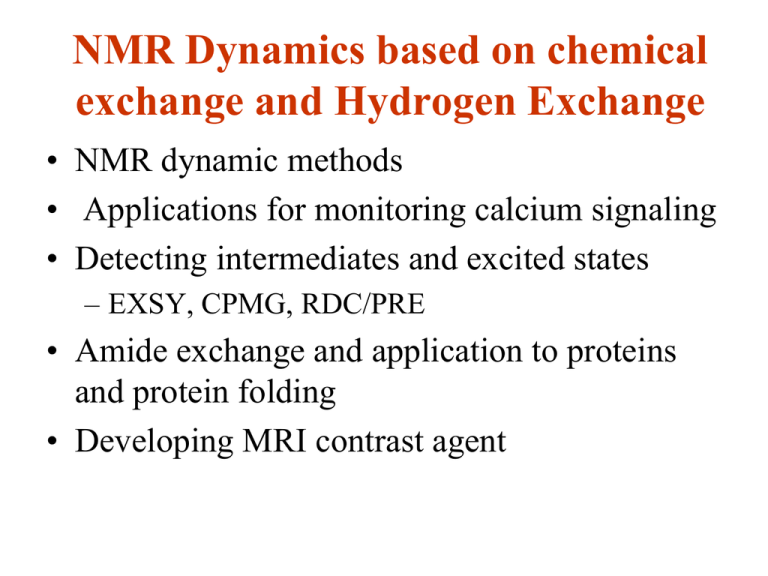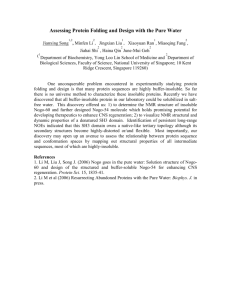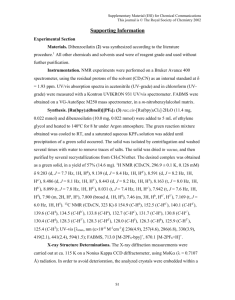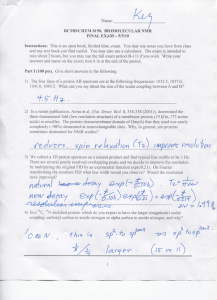NMR Dynamics based on chemical exchange and Hydrogen Exchange
advertisement

NMR Dynamics based on chemical exchange and Hydrogen Exchange • NMR dynamic methods • Applications for monitoring calcium signaling • Detecting intermediates and excited states – EXSY, CPMG, RDC/PRE • Amide exchange and application to proteins and protein folding • Developing MRI contrast agent Ca2+ Homeostasis and Signaling ([Ca2+]e 10–3 M) Ca2+ channels GPCR E NCX STIM1 RTK IP3R RyR SERCA SERCA ([Ca2+]i 10-7- 10–6 M) MCU/MiCa Letm1 Ca2+ IP3R Uniporter RyR CaM NCX/HCX Genes transcription (NFAT, CREB, DREAM) [Ca2+]I activated Buffers Buffers Effectors Ca2+ Ca2+iOscillation frequency 10-6 μs 10-3 ms 1 s 103 min 106 h The Connexin Family Tree 3 Söhl et al., Nat. Rev. Neurosci. 6: 191-200, 2005 Identifying CaM Binding Region in Gap Junction Connexins Score NH2 COOH 789999999999999876 Cx50_m 145 TKKFRLEGTLLRTYVCHI 162 789999999999987654 Cx46_h 136 RGRVRMAGALLRTYVFNI 153 899999999999766543 Cx44_s 133 RGKVRIAGALLRTYVFNI 150 479999999999999999 Cx43_h 142 HGKVKMRGGLLRTYIISI 161 000999999999999999 CaMKI_h 294 FAKSKWKQAFNATAVVRH 315 000999999999999999 CaMKII_h 289 NARRKLKGAILTTMLATR 310 xxBxB#xxx#xxxx#xxx 1 5 10 Y. Zhou. JJ Yang JBC. 2007; Zhou Y, Yang JJ. Biophys J. 2009 ; Y. Chen, .. JJ Yang Biochem J. 2011 Monitoring Cx Peptide and Calmodulin [Cx44]/[CaM] [Cx43]/[CaM] 0:1 0.4:1 0.8:1 1.2:1 9.2 9.1 9.0 T117 0.6:1 0.2 0.9:1 ppm-H K94 D64 G33 G61 G25 K148 A57 0 1.2:1 -0.1 T29 -0.2 0 0.5 1 1.5 [Cx43]/[CaM] T117 9.2 1H 9.1 (ppm) 133 115 134 113 132 114 133 115 134 113 132 114 133 115 134 113 132 114 133 115 134 113 132 114 133 115 134 113 132 A57 133 115 2 Y. Zhou. JJ Yang JBC. 2007 A57 114 2.0:1 8.3 132 114 0.3:1 0.1 8.4 113 T29 0:1 8.5 9.0 134 8.5 1H 8.4 (ppm) 5 8.3 Strong Binding Indication by Slow Exchange CaM : Cx50p 1:0 Free G33 105.2 105.4 105.6 8.70 8.65 8.60 CaM + Cx43p 8.55 105.2 1 : 0.4 105.4 105.6 8.70 8.65 8.60 8.55 8.70 8.65 8.60 8.55 8.65 8.60 8.55 105.2 1:1 105.4 105.6 105.2 1: 1.2 105.4 105.6 bound 8.70 6 Y. Chen, .. JJ Yang Biochem J. 2011 HSQC Spectra of Holo-CaM with Cx50 Peptide Holo-CaM Holo-CaM + Cx50p G33 T29 G134 T70 T117 F19 A128 L116 V136 I27 I130 K21 K148 K94 A147 I100 N137 D64 A57 7 Y. Chen, .. JJ Yang Biochem J. 2011 Integration of Calcium Signaling Via CaSR site5 Site 4 LB1 LB2 Site 1 Site 2 Site 3 Identification of Ca2+ binding sites in ECD of CaSR How can CaSR sense the change of Ca2+o , Phe within a narrow range? (multiple sites? cooperativity?) Identification of CaM binding region in c-tail of CaSR Y. Huang, JJ Yang, J Biol Chem. 2007; Yun Huang.. JJ Yang Biochemistry 2009; Y Hang, … JJ Yang, JBC 2010, Zhang, C, 2014 NMR Dynamic Experiments Initial NMR dynamics experiments in 1970s. Rapid advancements due to ability to label specific positions in bio-molecules and methodologies development Magnetization exchange spectroscopy (EXSY)-slow exchange 0.5 s-1 to over 50 s-1 CPMG relaxation dispersion: chemical shifts100~2000s-1, R1rho can extend to more rapid exchange (dot) Residual dipolar coupling (RDC) and PRE Spin relaxation for ns-ps CPMG and PRE are sensitive to low-lying excited states with populations > 0.5% H/D exchange can detect high energy excited states with much lower population A.Mittermaier, L. Kay (2009) Trends Biochem. Sci. 34, 601. A. Mittermaier, L. Kay (2006) Science. 312, 224 K. Wuthrich, G Wagner,(1978) Trends Biochem. Sci. 3, 227 Exchange Spectroscopy (EXSY) Mittermaier et al (2009) Trends Biochem. Sci. 34, 601. Slow conformational exchange in the protease ClpP ClpP, an oligomeric protease comprising 14 subunits with a total molecular mass of 300 kDa. (a) Surface representation of ClpP with two monomers shown as yellow and blue ribbons. Locations of dynamic isoleucine residues are identified by green and red circles. Substrate entry pores are indicated with blue arrows. (b) The 1H/13C methyl TROSY correlation spectrum collected for a uniformly [15N, 2H], Ile δ1 [13C,1H] labeled ClpP sample. I149 and I151 are each associated with two δ1 methyl peaks, designated F and S, reflecting slow exchange between two distinct, functionally important, conformations. (50C, rotational correlational time >0.4 us) R.Sprangers, PNAS, et al.2005 Wang JM, Cell, 1997 Carr–Purcell–Meiboom–Gill (CPMG) Relaxation Dispersion 100 s-1 ∼ 2000 s-1 Exchange between ground state and excited state is in the millisecond time scale kAB kex = kAB + kBA A B kBA kBA > kAB Shape of the dispersion depend on: • populations of the two states • chemical shift difference • the rate of exchange In a typical series of experiments, variable numbers of refocusing pulses are applied to magnetization as it evolves under the influence of a chemical shift that varies stochastically due to the exchange process Baldwin et al (2009) Nature Chem Biol 5, 808. Minisec Dynamics Relaxation Dispersion of DHFR Boehr et al (2006) Science 313, 1638. Relaxation Dispersion (Continue) Differences in chemical shifts between ground and excited states () correlate with differences in peak positions between intermediates (), suggesting the excited states are similar to the conformation of the intermediates in the preceding or following step in the catalytic cycle. Boehr et al (2006) Science 313, 1638. Residual Dipolar Coupling (RDC) Mittermaier et al (2009) Trends Biochem. Sci. 34, 601. Spin Relaxation and Paramagnetic Relaxation Enhancement Mittermaier et al (2009) Trends Biochem. Sci. 34, 601. PRE Study of Maltose Binding Protein • PRE of holo form agree with Xray structure • PRE of apo form is larger than X-ray structure • The apo form is in a transient close form (5%) Grey: N-terminal domain Blue: C-terminal domain, apo Red: C-terminal domain, holo Mittermaier et al (2009) Trends Biochem. Sci. 34, 601. Hydrogen Exchange Method Hydrogen exchange (HX) techniques is described for measuring the approximate exchange rates of the more labile amide protons in a macromolecule. The exchangeable amides in proteins are: Exchangeable Nucleotides Hydrogen-Exchange Chemistry A minimum ~ pH 3.5 > 1hr at pH 3 < 1ms at pH 10 • Hx rate is catalyzed by OH- and H+ kintrinsic kex = koH [OH-] + kH[H+] + kw • All exchange rates are referenced to random coil polyAla at 0 C. • HX rates are sensitive to pH,local chemical environment, solvent, sidechain type, neighboring amino acids and temperature • kintrinsic for each amino acid is different pD = pH* + 0.4 Bai. And Englander. (1993) Proteins, 17, 75; Koide S.. and Wright PE J Biomol NMR. 1995 Nov;6(3):306-12. Simulated Exchange Rates for Labile Protons of Polypeptides • In H2O solution at 25 °C. • Im stands for imidazole ring NH, Gua for guanidinium NH, bb for backbone. • The amide protons have a large range of possible exchange rates under physiological pH (pH 6.5– 7.5). Wuthrich &Wagner JMB 1979 HX vs. Protein Structure In proteins, HX rates can be altered: H-bonding Shielding in the center of protein Shielding by binding another molecules pH and temperature Extremely slow exchange can be months,yrs Protection factor p = kintrinsic/kobs p > 106-107 for slow exchange Amide exchange rate contains information about secondary structural elements Hx Mechanism (Ex1/EX2) ko kintrinc Close p Open Exchanged kcl -Hvidt & Nielsen, 1966 • Solvent penetrates protein secondary structure • A protected amide hydrogen is ‘closed’ to exchange and becomes accessible to exchange through an ‘open’ state at the exchange rate for an unstructured peptide. Ex1: kintrinc >> kcl kobs = kop independent of pH Ex2: kintrinc << kcl kobs = kopkintrinc pH dependent Ex2 is typically encounted in proteins under conditions where folded state is stable and intrinsic exchange is relative slow HX is an excellent way to look at the stability of proteins • The rates of amide proton exchange for individual protons can be related to equilibrium constants for opening of individual hydrogen bonds. Knowing the equilibrium constants, one can calculate the free energy for the conformational transition which allows exchange to occur. • When certain protons are only exposed in the completely unfolded form then the equilibrium constants and Gs correspond to the global unfolding reaction. These protons are usually the slowest exchanging protons in the molecule. GHX = -RT ln(kobs / kintrinc ) • For mutation, the change of stability: GHX = (GHX )wt- (GHX )mut =-RT ln (kexwt /kexmut ) Amide Exchange Rates •Adding D2O to our H2O solution and take spectra at different times, signals from different amide protons will decrease in size at different rates. We look at the NH to Ha fingerprint at different times in DQF-COSY or HSQC. 4.0 t = 0 - No D2O Add D2O 4.0 (Has) t = t1 4.0 t = t2 8.0 (NHs) 7.0 Amide Exchange Rates in ACP • Residues at the center of helices and hydrophobic core have slow exchange rates Kima Y, et al, BBRC, 2006 • The overall protection factors (< 10 4.5) are smaller than other proteins suggesting that ACP has high mobility • Helix II exchanges faster than helix I and helix III suggesting that Helix II is highly dynamic. Unfolding/Folding and Misfolding Competition Hydrogen Exchange 25x dilution 6M GuHCl H2O pH 7.5 Drop pH 3.8 D2O Concentrating 1min Phosphate buffer pH7.5 NMR • The refolding experiment involved dilution of droplets of protein denatured in 6 M GuHCl in H2O solution into a denaturant free solution of D2O to initiate refolding and hydrogen exchange simultaneously. • After folding completed, HX is quenched by lowing the pH. • Comparing 2D NMR spectrum of the refolded protein with that was not denatured. Residues protected early in refolding can be detected using NMR. Competition HX of lysozyme • Using 65 slowly exchanging amide hydrogen as probes. The majority of residues in bdomain have exchange >30%. The majority of residues in adomain have exchange <30% suggesting that two structural domains of lysozyme are folding domains that differ significantly in the extent to which protected structure accumulates early in the folding process. Miranker et al., Nature, 1991 Pulsed-Label Hydrogen Exchange •After an adjustable refolding time, tf, the protein is subjected to a short high pH pulse, where exchange of the unprotected NHs is very fast. NHs protected by structure within the folding time does not exchange during the short pulse •After a pulse time tp. The D to H exchange is quenched by rapidly lowering the pH. •After folding completed, the pattern of NH and ND labels in the refolded protein is analyzed by 2D NMR. •Increasing tf time, proton occupancies measured in the NMR spectrum decreases. Plotting proton occupancy vs. folding time tf. Identifying Folding Pathway by HX Pulse-Labeling (a) pure 2-state All probes achieve 100% protection at the same rate in a single kinetic step. (b) U -> I -> N sequential, I has A&B H-bonds with the same HX constant (c) U1 -> N(30%) U2 -> N(70%) two heterogeneous parallel paths (d) U1-> N U2->I->N contribution of intermediate and heterogeneous folding Parallel Folding Pathway of Lysozyme • All probes (50% of 126 amides) have one fast phase and one slow phase • Fast phase rates for both aand b domains are 10 ms • Slow phase rates for a is 65 ms and b is 350 ms, respectively. • a domains folds before b domain and different populations of molecules folded by kinetically distinct pathways Additional Methods for Amide-Water Exchange • • • • • • • • Hwang TL, Mori S. Shaka, AJ, and van Zijl PC, Application of Phase-Modulated CLEAN Chemical EX-change Spectroscopy (CLEANEX-PM) to detect water-protein proton exchange and intermolecular NOEs. JACS, 1997, 119,6203-6204. Hwang TL, van Zijl PC, Mori S. Accurate quantitation of water-amide proton exchange rates using the phase-modulated CLEAN chemical EXchange (CLEANEX-PM) approach with a FastHSQC (FHSQC) detection scheme.J Biomol NMR. 1998 Feb;11(2):221-6. Clean SEA-HSQC: a method to map solvent exposed amides in large non-deuterated proteins with gradient-enhanced HSQC J Biomol NMR 2002 Aug;23(4):317-22 Mori S, Abeygunawardana C, Johnson MO, van Zijl PC. Improved sensitivity of HSQC spectra of exchanging protons at short interscan delays using a new fast HSQC (FHSQC) detection scheme that avoids water saturation. J Magn Reson B 1995 Jul;108(1):94-8 Erratum in: J Magn Reson B 1996 Mar;110(3):321 Bougault C, Feng L, Glushka J, Kupce E, Prestegard JH. Quantitation of rapid proton-deuteron amide exchange using hadamard spectroscopy. J Biomol NMR. 2004 Apr;28(4):385-90. Miranker A., Robinson CVm Radford, SE, Aplin RT, Dobson CM. Detection of transient protein folding populations by mass spectrometry. Science. 1993 Nov 5;262(5135):896-900. Carulla N, Caddy GL, Hall DR, Zurdo J, Gairi M, Feliz M, Giralt E, Robinson CV, Dobson CM. Molecular recycling within amyloid fibrils.Nature. 2005 Jul 28;436(7050):554-8. Feng L, Orlando R, Prestegard JH. Mass spectrometry assisted assignment of NMR resonances in 15N labeled proteins.J Am Chem Soc. 2004 Nov 10;126(44):14377-9. Macnaughtan MA, Kane AM, Prestegard JH. Mass spectrometry assisted assignment of NMR resonances in reductively 13C-methylated proteins. J Am Chem Soc. 2005 Dec 21;127(50):17626-7. CLEANEX-PM spin-locking sequence: 135°(x) 120° (-x) 110° (x) 110°(-x) 120°(x) 135° (-x) CLEANX-PM has the ability to specifically monitor water-proton exchange without 1) exchange relayed NOE/ROE from rapidly exchanging protons (hydroxyl or amide groups) in the macromolecules, 2) intra-molecular NOE/ROE peaks from protein CaH protons which has chemical shifts coincident with water, or TOCSY-type interactions. FHSQC CLEANEX-PM The FHSQC indicates proton signal that remain at the amide resonance through out the pulse sequence. The CLEANEX-PM indicates 1H signals that initiate in the 1H O resonance and then transfer to 1H amide resonance 2 during the mixing period of the pulse sequence. Staphylococcal nuclease –Hwang et al., 1998 Conventional [1H,15N]-HSQC spectrum of human ubiquitin. A 0.5 mM15N-labeled sample was prepared in 50 mMpotassium phosphate buffer in H2O/D2O 5/95, pH=6.2 600 MHz with cryoprobe. it required approximately 21 min using 128 t1 time increments and 4 scans per increment. Reconstructed Hadamard [1H,15N]HSQC Spectra for Ubiquitin (A) Data in 1H2O collected with 128 t1 increments in 20 min. The sample was then lyophilized overnight and brought back to its initial volume with 99.9% 2H2O and immediately returned to the spectrometer for rapid collection of a series of Hadamard spectra. (B) First point after 1 min in 2H2O collected with 4 scans in 42 s. Cross-peak intensities as a function of time Lines are best fits to I(t) =Io(exp(-kt)+const). The precision of the data is quite high with the estimated errors for rates in the range of 1 × 10-3 min1 being on the order of 5%. Rates derived also show reasonable agreement with previously published rates. Intermediates Determined by H/D Exchange Englander (2005) PNAS 102, 4741. Limitations of Clinically approved Contrast agents • • • Paramagnetic nanoparticles • Low relaxivity and requires high dose injection (0.3-0.5 M) Low sensitivity, and low accuracy/specificity Low S/N, Conc> 0.10 mM No capability for biomarkers at uM~ nM for molecular imaging Low resolution – Detection size > 1-2 cm – Non-ideal PK/PD with limited MRI window required for high quality imaging Gd Toxicity/Blackbox warning There is a strong need to develop MRI contrast agents with high relaxivity, optimized in vivo retention time, organ preference, and targeting capability. Lauffer et al, 1987, Xue et al., 2013, 2014 Contrast Agents vs. relaxation i ii Kex Gd Rf Rf Rs Kex Gd Kex Gd Rf 1 cq T1 T1M M 1 1 1 1 c T1e m R Current CAs A major barrier to the application of MRI technique is its low sensitivity and contrast limited by the fast rotational correlation time of the molecule (ps). Macromolecule generated by either covalent binding or the non-covalent nature of the binding between the monomeric agent and the macromolecules has the improvement in proton relaxivity is much less than the expected increase based on the molecular-weight increase due to high internal mobility of the paramagnetic moiety and limited water exchange rate. ProCAs developed by protein design with increased relaxivity by controlling relaxation and the capability of targeting specific molecular entities such as cancer biomarkers. Yang, JJ, JACS, 2010 , Wei et al., 2009, Qiao et al., 2011 Increase Both R1 and R2 by Protein Design 90 r2, ProCA32 r2, ProCA 1.4 T 3 T 7 T Relaxivity (mM-1 s-1) r1, ProCA32 r1, ProCA r2, Gd-DTPA r2, Clinical 60 r1, Gd-DTPA r1, Clinical 30 1 cq 1 1 1 1 T1 T1M M c T1e m R 1 cq 2nd 2nd T12nd T1m m2 nd 0 0.01 1 100 10000 Larmar frequency (MHz) Protein-based Contrast Agents (ProCAs) 2 2 2 2 7 2nd 3 2nd 1 2 I g B 0 c 2 c1 S ( S 1)( ) [ ] 2nd 2 nd 6 2 nd 2 15 4 T (r ) (1 ) (1 2nd ) 2 1m GdH s c2 I c1 At 20 MHz with rGdH2nd=5 Å and q=6, the second sphere relaxivity could potentially ProCA1 as a MRI contrast agent A H2O PEG H2O D 62 E 15 D 58 Gd K 66 D 56 D 64 K 45 9.05 ns 9.20 ns K 47 PEG PEG •q=2.0 q = 1. 8 Sample Gd3+ Zn2+ Ca2+ Mg2+ Log (KGd/KZn) Log (KGd/KCa) Log (KGd/KMg) DTPA28 22.45 18.29 10.75 18.20 4.17 11.70 4.25 DTPABMA41 16.85 12.04 7.17 na* 4.81 9.68 na* CA1.CD2 12.06 6.72 <2.22 <2.0 5.34 >9.84 >10.06 45 HER2targeted ProCA Detects Breast and Ovarian Cancers depending on HER2 Expression Levels Pre 24 hr 30 min MDA-MB-231 SKOV-3 Intensity Enhancement 24 hr 24 hr 40 Blood Vessel Positive tumor stained with ProCA1-affi-m Positive tumor stained with HER2 antibody 4 hr 4 hr Enhancement % Blood Vessel SKOV-3 MDA-MB-231 30 20 10 0 5 min 30 min Positive tumor stained with ProCA1-affi-m Positive tumor stained with HER2 antibody 3 hr 24 hr 52 hr Time points Excellent Tumor Penetration And Distribution, Superior Than Protein-based Contrast Agents (ProCAs) A H2O PEG H2O D 62 E 15 D 58 Gd K 66 D 56 D 64 K 45 K 47 PEG PEG GRPR, GPCR • First computational design of Gd3+ -binding site in proteins as novel protein MRI reagents with strong metal stability and selectivity • 10-20 fold in vitro increases in R1 and R2, high R1 at 7T • 100 fold increase in in vivo detection resolution. Extend to earlier and accurate detection of liver lesion size from > 2 cm to <0.25 mm micrometstasis by dual ratiometric imaging • ProCAs increase specificity by enabling molecular imaging of breast and prostate cancer biomarkers Her2/EGFR and GRPR with enhanced sensitivity, optimized retention time, and proper tissue/tumor penetration • 20-100 fold low dose injection, biocompatible, no acute toxicty Xue, 2013, 2014, Qiao, 2014, L. Wei et al., 2010, Fan Pu unpublished





